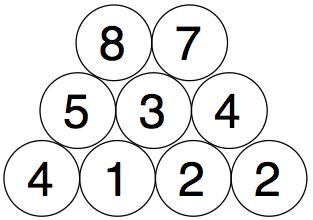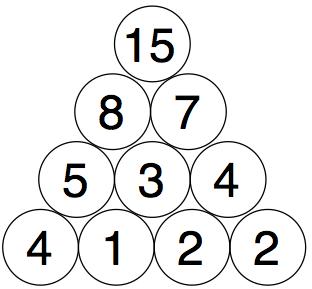Skip over navigation


Or search by topic
Number and algebra
Geometry and measure
Probability and statistics
Working mathematically
Advanced mathematics
For younger learners
Build it Up
Age 7 to 11
Challenge Level 





We start with any four numbers (not zero!):

We then add them in pairs and place the total above them:

And we then add in pairs the new numbers we just got:

We do the same with those two numbers to get our final number:


We then add them in pairs and place the total above them:

And we then add in pairs the new numbers we just got:

We do the same with those two numbers to get our final number:

You need to find four starting numbers to place at the bottom so that the top number will be 15.
Try to find as many sets of four starting numbers as you can.
Think about good ways to do this. Maybe use a system!
What little change can you make to the rules to explore again?
What new ideas can you think of to make this different? Explore those!
You may like to take a look at the follow-on activity Build it up More.
Related Collections
You may also like
Consecutive Numbers
An investigation involving adding and subtracting sets of consecutive numbers. Lots to find out, lots to explore.
Roll These Dice
Roll two red dice and a green dice. Add the two numbers on the red dice and take away the number on the green. What are all the different possible answers?

